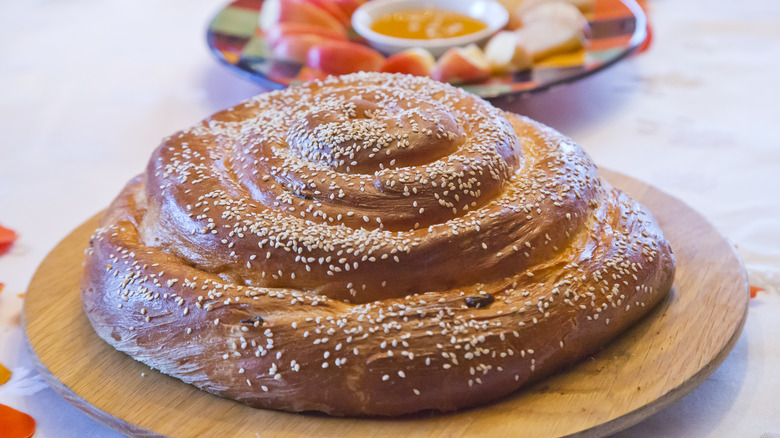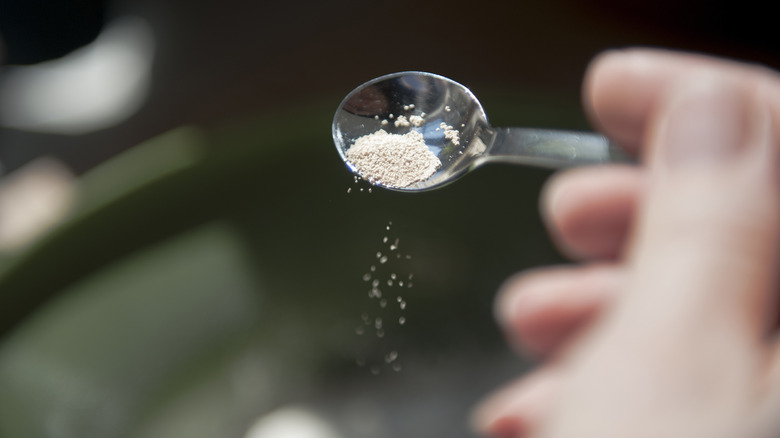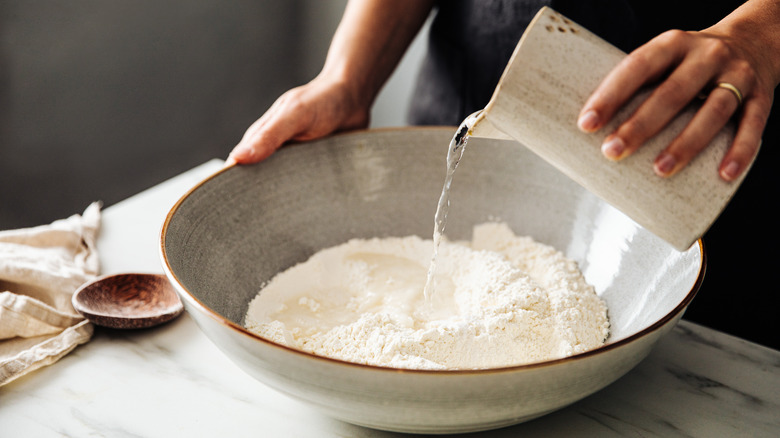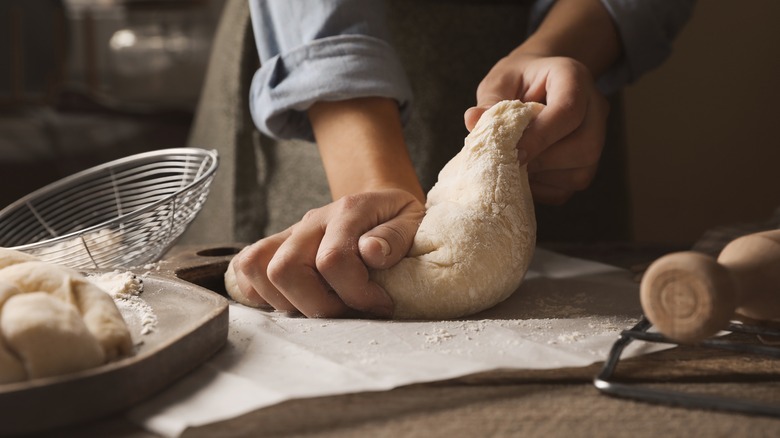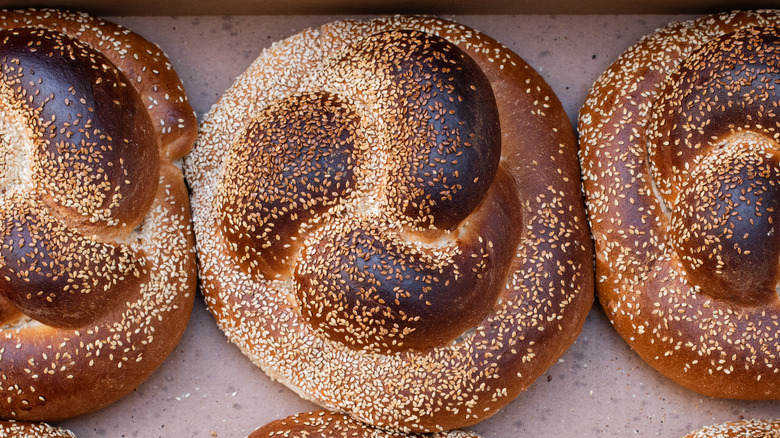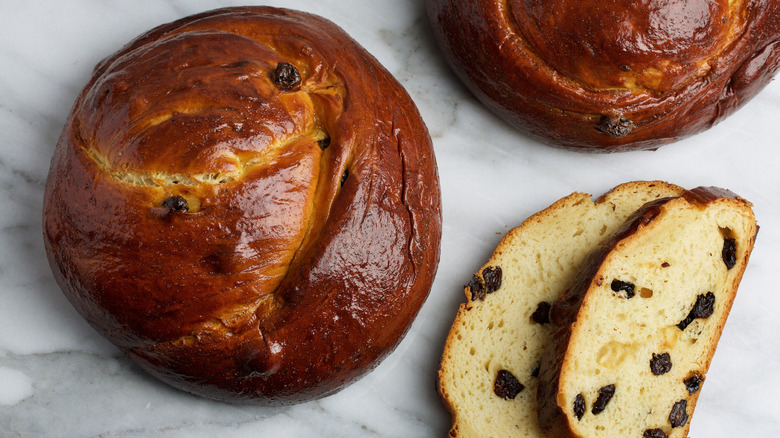Everything You Need To Know To Make Incredible Challah For Rosh Hashanah
Challah is a staple of Jewish holidays all around the year, but the shape of each loaf can change depending on the occasion. On Rosh Hashanah, the classic braided challah is swapped out for round loaves, whose circular shapes represent the cyclical nature of time, and a wish for endless blessings in the New Year and beyond. No matter the occasion, challah holds a special place on the table, and it's even better when it comes fresh from your own oven.
To help you master homemade challah, Chowhound spoke to Amy Emberling, Managing Partner at Zingerman's Bakehouse in Ann Arbor, Michigan to get her tips on the perfect loaf. It starts with simple ingredients that anyone can get their hands on, and it doesn't take any fancy techniques, just care and patience. What Emberling emphasizes more than anything is the fact that challah is versatile, and it's easy to make a recipe work for you.
The right yeast to use for homemade challah
Yeast is the key to almost every type of bread, responsible for proofing the loaf, and therefore determining its final texture. There are two main options when it comes to baking: fresh and dry. Amy Emberling says, "Either form of yeast can be used, but not in the same quantities." Dry yeast is significantly stronger than its fresh counterpart. To use the former in place of the latter, Emberling simply multiplies the amount of fresh yeast by 0.40 to determine the right quantity of dry yeast. However, she points out, "Very few home recipes are written for fresh yeast though, so this shouldn't be a problem."
Almost every challah recipe you come across will call for dry yeast. The question is, what kind of dry yeast should you use? Recipes will either call for active dry yeast, which must be activated in warm water before adding it to bread dough, or instant yeast, which can be added directly to your dough with the dry ingredients. You can actually substitute one for the other without changing the measurements, but the active version can make the overall rising time longer. If your recipe calls for instant yeast and you only have the active kind, make sure to add it to your wet ingredients first and let it bloom.
The right flour to use for homemade challah
Most challah recipes call for regular, all-purpose flour, but Amy Emberling says, "There's no 'best' flour for challah. It can be made with a wide variety of flour combinations." She notes that bread flour isn't really useful for challah. Why? A big difference between bread all-purpose and bread flour is that the latter creates more gluten in the dough, making the bread airy and chewy. That's the kind of texture you want from something like a baguette or a bagel, but not challah, which should be dense and soft in contrast.
If you are looking to vary the type of flour in your challah, Emberling recommends trying whole wheat flour. This will make for a more flavorful challah, giving it sweet, nutty notes. However, she cautions, "Don't substitute more than 25% of the white flour with whole wheat the first time you're making the recipe." Too much whole wheat will make the dough drier, and it can throw the balance between your dry and wet ingredients into disarray.
How to knead and proof challah for Rosh Hashanah
Proofing is arguably the hardest step in baking bread, and kneading isn't far behind. Both steps take a fair bit of time and patience. As far as kneading goes, the traditional route is always to do it by hand until the dough is smooth. This can take as much as 15 minutes to fully complete. For a faster alternative that's easier on the arms, you can use a stand mixer, which should only take a few minutes. Either approach works, and Amy Emberling advises to "use the method you're most comfortable with."
To ensure a proper rise on your homemade challah, Emberling recommends placing the dough in your oven with the proofer setting on. If you don't have a proofer setting on your oven, don't worry. "Keep your challah covered in an oiled container, in a warm and humid spot in your house," Emberling advises. The proper rising time should be indicated by the recipe you pick, but there will generally be a two-stage proofing process. "Generally, the first rise is for 1-1.5 hours, then you pre-shape your dough, let it rest for 20 minutes, final shape it, and let it proof again for another 1.5 hours." The easiest way to tell when your challah is ready to bake is to gently press the loaf with your finger. If it leaves a dent, the dough needs more rising time, but if the dough springs back, it's time to bake.
How to shape and bake the perfect loaf
Challah takes on different shapes depending on what occasion you're making it for. There are ladder-shaped loaves of challah for the pilgrimage festivals of Sukkot and Shavout and bird-shaped loaves for Yom Kippur, but Rosh Hashanah is best associated with round challah. In addition to representing the cycle of time, the shape is symbolic of a crown for God. Round loaves of challah are also known as keter challah, from the Hebrew word for "crown." When shaping a round of challah, you can choose a simple, swirled shape, or for more advanced bakers, a braided round. Amy Emberling cautions that "the tighter the shape and greater the quantity of dough could require more proofing time"
When baking challah, the crust is a top priority. "Challah should have a thin, delicate crust, not a chewy, thick one," says Emberling. That actually makes this type of bread ideal for home ovens. She adds, "The crust is most beautiful when it is a light mahogany color," which you'll need an egg wash to accomplish. Mix an egg yolk with a teaspoon of water and brush it over the top of the loaf (you may need more yolks and water, depending on the size of your challah). This will achieve the desired color and help to ensure the crust has the right texture.
Seasonal add-ins for challah
There are different ingredients that you can add to your challah to make things a little bit more interesting. It's also a holiday tradition, as Amy Emberling points out. "Adding something sweet for a sweet new year is a classic addition for a Rosh Hashanah challah," she says. Raisins are a particularly popular holiday option, and Emberling notes that Zingerman's Rosh Hashanah challah specifically includes rum-soaked raisins. Other dried fruits, such as dates, as well as candied fruits make great additions to a loaf of challah.
Emberling also recommends taking advantage of whatever sweet fruits are in season where you live. For example, apples are a common autumn crop in much of the United States, making them a seasonally appropriate addition to a Rosh Hashanah challah. Emberling recommends roasting the apples and incorporating some cinnamon and honey. You can also use seeds and spices to add flavor to your bread. Emberling highlights anise as a particularly aromatic option that will add a warm autumnal note to the dough. In the end, it's all about keeping the time of year in mind and leaning into seasonal sweets.
